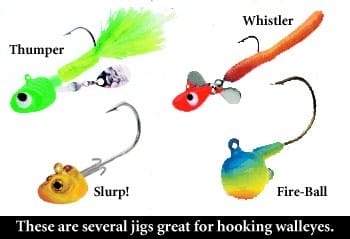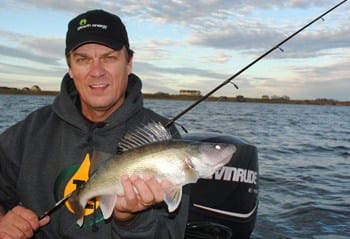
As the snow and ice go away across the Midwest, and as we get closer to open water fishing, lots of anglers start to do an inventory of their lures. Early in the fishing season, jigs are walleye catchers. In fact, if you spoke with several veteran walleye anglers, most, if not all of them, would name a jig of some sort as their go-to bait for early season walleyes.
However, there are many different jigs available to anglers today. They come in a variety of head shapes, colors, hook sizes and body materials. Here are some things to keep in mind as you’re going through your selection of jigs.
Early in the season, we’re going to be tipping our jigs with live bait, probably minnows. Some jigs, most notably Fire-Ball jigs, were designed to be used with live-bait. They have a short shank, wide-gap hook that increases your hooking percentages.
However, there are a couple different types of Fire-Ball jigs, a round head and a stand-up head. Both are outstanding jigs, but both have a different function.
The stand-up version, when at rest, stands up on the bottom. This is an advantage early in the season when a slow presentation is desired. A dragging technique is very productive for walleyes early in the year when the water is cold. You’ll want to give the jig some pauses as it is retrieved. With a stand-up head, when the jig is paused, the minnow remains upright and can be easily slurped in by a walleye. A round head jig, when paused, lays flat on the bottom, so the minnow won’t be as visible.
Round head jigs certainly have a place in our fishing. When you’re fishing deep water, the round head sinks faster, and it also is very good when you want to move the bait faster. In fact, round head jigs are what are used most of the time by walleye anglers. There are times though when a stand-up head is more productive.
More and more, walleye chasers are using soft bait like Gulp! and PowerBait. Soft bait is easy to use. Walleyes like to eat it, and it lasts a long time. To maximize the effectiveness of soft bait, you need a jig designed for use with soft bait. A Slurp! Jig is just such a jig.

Slurp! Jigs have a much longer hook than most jigs. Almost all the time, it’s more effective to thread soft bait onto the jig. You want the head of the soft bait right next to the jig head, and you want the hook coming out in about the middle of the back of the bait. The longer hook enables us to more effectively thread the soft bait on the jig. Good soft bait jigs also have bait-keepers that prevent the bait from constantly sliding down the hook.
Then we have jigs with spinners like the Thumper Jig, and jigs with propellers like a Whistler Jig. These are very effective in stained water. The added flash and vibration of these jigs help the fish find them when visibility is limited, and the head style makes them very good swimming jigs.
There are also jigs that are designed to resist snagging, so they can be worked effectively around weeds or timber.
The thing to keep in mind when selecting a jig is that certain jigs were designed to be most effective in certain conditions. Match the jig you’re using to the condition, and you’ll catch more walleyes.
To see all the newest episodes of Fishing the Midwest television, visit fishingthemidwest.com







